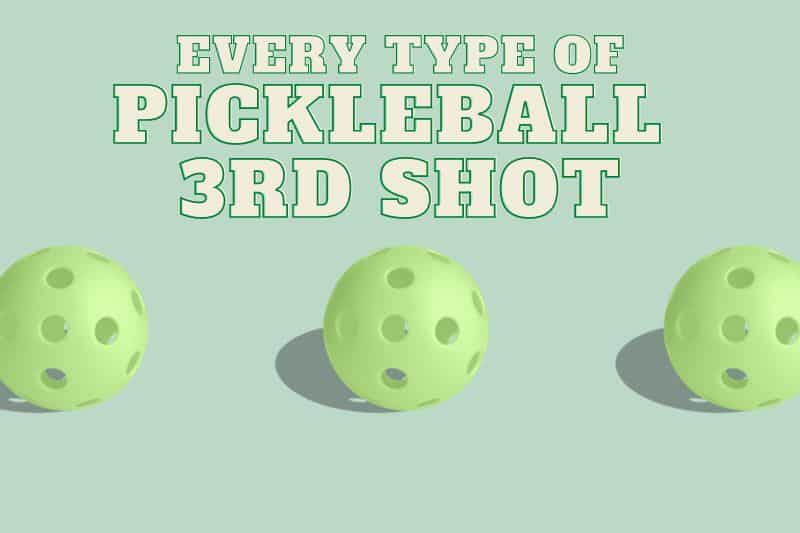
One of the most important shots in pickleball is the third shot. In fact, how good your third shot can differentiate you as a beginner, intermediate, or advanced player. So if you’re looking to level up, here is every type of third shot in pickleball to know and their advantages.
Every Type Of Third Shot In Pickleball
The Drive
The drive can be an effective third shot against beginner to intermediate players. At those levels, many players don’t have the proper technique to block a drive. But even at higher levels, the drive can be used in a combo where one player drives to an opponent, causing a pop-up while the other player is ready to put away the ball.
You will see women’s pro players Anna Leigh Waters and Leigh Waters use this approach often in their matches. The drive is great when your opponents are not able to handle pace and speed. However, if you choose to drive your third shot, anticipate that you will have to make the next shot.
Whether that is because your opponent has popped the ball up or because they punched it back. You don’t want to assume that your third shot drive is a putaway. Be ready to follow up with the next shot, whether another drive or a drop.
The Flat Drop
The flat drop is a simple drop without adding any underspin or topspin to the ball. It is a shot that anyone can do, regardless of sports background. While a drop is meant to be a soft shot into your opponent’s kitchen, that is not your primary goal. The goal of your third shot drop is to make it so that your opponent will have to hit up on the ball at an upward angle.
So what this means is you want your opponent’s contact point with the ball to be as low as possible. The contact point is where your opponent’s paddle touches the ball. Obviously, you don’t want high drops where your opponents can smash it at a downward angle.
However, if your drop arches high but lands where your opponent’s contact point is low, that is still considered a good drop. You also want to keep your opponent’s physicality in mind. If one of your opponents has long arms and a big reach, it may seem like it’s impossible to get a good drop.
In that case, you may want to drop to their partner with a shorter reach. Or aim to drop at their backhand since most player’s backhand tends to be weaker than their forehands.
The Slice Drop
For many reasons, a slice drop or an underspin drop is a powerful shot to learn and master. First, it creates a backspin which keeps the ball lower. As your opponent tries to contact the ball in the air, the ball can easily go into the net. That is unless they counter the ball by applying a counter spin or topspin roll.
If your opponent allows the ball to bounce first, the ball will skid if you apply heavy backspin. So by the time your opponent tries to make their next shot, the ball will have traveled further back than they may realize.
With heavy backspin, the ball also bounces lower. That makes it harder for your opponent to return that shot because they have to get under the ball more to compensate.
A slice drop is considered an advanced shot. But you can learn it when you think of a drop as a longer, bigger dink. Or a shorter, slice return. If you’re playing against someone with a long reach, a slice drop is one way to buy yourself time to get to the kitchen because the ball stays in the air longer.
The Topspin Drop
The beauty of topspin is that it allows the ball to descend a lot quicker than it may look. That is why topspin drives may seem like they will go out of bounds but tend to stay in. Topspin drops make the ball drop in a lot quicker instead of staying in the air as it does in a flat or underspin drop.
This makes it harder for your opponent to judge where the ball will land. Even if the arch of your topspin drop is higher, it tends to drop before your opponent may be able to take it in the air. Topspin drops are also a great counter to heavy slice returns.
You know that a slice return creates a backspin on the ball. But applying topspin sends it back and continues the spin that the ball came with. Topspin may be one of the harder shots to learn because you may only be used to applying topspin on a drive. However, it is a shot that is worth learning and using as a valuable tool against any type of opponent.
The Lob
While the lob is not a popular choice as a third shot in pickleball, it can be as effective as any of the other third shots. If both of your opponents are already at the kitchen, a lob is a great way to make one or both go back toward the baseline.
If you’re struggling with making a good third drop for a slice return that is heavy with backspin, a lob is also a great option. Or if the serve return causes you to be unbalanced in some ways. Sometimes a serve return can be a lot deeper than you expected. You may be in the middle of backing up while having to make your third shot.
Or you’re having to reach for the ball. A lob as a third shot is a way that can buy you time as you get back in your ready, balanced position. You just want to make your lobs stay inbounds when it lands while being high enough to be out of your opponent’s reach.
Getting the right touch for lobbing may require drilling and practice. But it is not one that should be overlooked.
More Pickleball Tips
Read Also: 5 Advanced Pickleball Techniques And Shots To Level Up
Read Next: The Pickleball Shot You’re Overlooking
Recommended Outdoor Pickleballs: Franklin X-40 Pickleball Balls
Recommended Indoor Pickleballs: Onix Pure 2 Indoor Pickleball Balls

